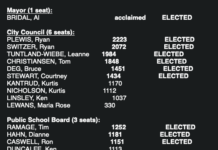By Matthew Liebenberg
The Chinook School Division will be drawing on reserves to balance the 2023-24 budget due to the growing gap between cost pressures and the provincial funding allocation.
The budget for the upcoming school year was approved during a regular Chinook Board of Education meeting, June 26.
Total operational expenditures will be $93.68 million, which includes salary increases and inflationary costs for insurance, fuel and utilities. Reserves will be used to fund a cash deficit of $3.34 million. The school division’s revenue from grants, including provincial funding, will be $84.79 million.
“The key aspect of this is the board made the decision to subsidize the $3.34 million out of the reserves, because the funding falls $3.34 million short of that,” Director of Education Mark Benesh said after the meeting. “The goal here is to not impact classrooms across the division by making additional reductions that we’ve done in the past: $6 million in 2016, about $3 million a few years ago, and $10 million over the last seven years. We just want to support our classrooms as best we can, given the limited funding we get provincially.”
The use of reserves is an option that might not be available to the Chinook Board of Education in the near future if the funding gap continues. By the end of the next school year the school division will have used 65 per cent of reserves over three years.
“In the 2025-26 school year, at some point in that year, we would have no reserves left,” he said. “The way we’re going over the next couple of years, we’ll basically tap it out.”
The funding gap is a result of a lower level of funding from the province over several years. The school division received five per cent less funding over the last seven years. Chinook had 5,910 students in the 2015-16 school year and it expects to have 5,964 students in the 2023-24 school year.
The provincial government announced additional funding for school divisions on June 1 to supplement the original budget allocation made in March. One portion of the additional funding is aimed at funding enrolment growth. This might result in an extra $140,000 for Chinook School Division based on projected enrolment in 2023-24. However, this will still mean the school division is receiving $660 less per student than in 2016.
“It would mean that we’ve got a lot less teachers, a lot less supports, a lot less coaches, counsellors, a lot less everything,” Benesh said. “They all add into that $660. But the first driver would be we have just less teachers in those classrooms. So it’s $660 less, but when you apply that out, it’s $3 million of investment across the school division, and it’s in every area.”
The other portion of the provincial government’s announcement of extra funds to school divisions is aimed at funding the hiring of classroom and other support staff to address the challenges of classroom size and composition. This allocation to Chinook School Division will be $779,434 in the 2023-24 budget, which is a funding increase of one per cent.
According to Benesh this additional funding amount presents a dilemma to the school division, because it is only for one year and there is no guarantee that it will continue thereafter or applied through a funding formula, which might reduce the amount in future years.
“So the board has just been put in a very tough situation to have to figure out how to spend these dollars, because you lose them if you don’t,” he said. “But the fact is, we don’t want to hire a bunch of people we have to let go.”
The intention of the school division with the 2023-24 budget is basically to maintain the status quo and to absorb inflationary and cost pressures.
“There’s been some reduction,” he said. “Each year we make some reductions looking at all circumstances, because things change year to year, but we hope that utilizing reserves for that amount of money will lessen any impact there might be. … There’s always a retirement here or circumstance where there may be some reduction, but that’s very isolated. The reality of the circumstances is that we’ve pretty much maintained a status quo budget related to staffing.”
The main contributing factors to the school division’s budget shortfall is transportation costs and salary expenses. The school division is funded 80 cents for every $1 of transportation cost.
“Our fixed costs to run buses across Chinook are $2 million more than the province provides,” he noted. “The other part is that we are underfunded on the number of teachers that we have in classrooms. That’s probably about $1.5 million. The funding that we got recently offsets some of that deficit, but it doesn’t take it away. All it did is impact it slightly so that we’re using a little less reserves than we would have been a few months ago.”
The Chinook Board of Education sent out a detailed explanatory letter to parents and staff in late May to highlight the budgetary funding gap.
“The purpose of the letter was to help people understand the difficult circumstance of the board in supporting their children,” he said. “We want to help parents understand our circumstance so they also can advocate, because we advocate all the time. … We are planning some town hall meetings in the fall. The goal of it is just to be open and share and help people understand our situation, similar to the way the letter did, but just in person.”






